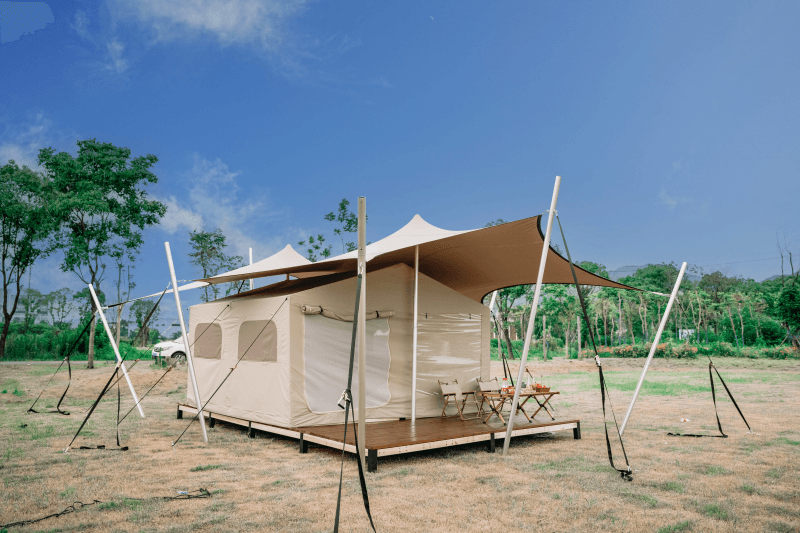Understanding lightweight tents: An Introduction
The demand for lightweight tents has surged in recent years, driven by an increasing preference for less cumbersome camping gear among outdoor enthusiasts. These tents offer considerable advantages in terms of portability and ease of setup. However, they often raise questions regarding their ability to withstand strong winds. While they might weigh less, the concern is whether their lightweight design compromises durability and stability in adverse weather conditions. Wholesale suppliers and factories are continually innovating to strike the right balance between weight and durability, catering to this growing market segment.
The Physics of Wind Impacts on Tents
Wind Force: Non-linear Relationship
Understanding the dynamics of wind is crucial in assessing a tent’s ability to endure strong gusts. Wind exerts a force that is not linear but quadratic, meaning if the wind speed doubles, the force it exerts quadruples. For camping tents, this translates to much higher stress on the materials and structure when wind speeds exceed a certain threshold. This principle challenges tent factories and manufacturers to engineer products that can handle such exponential forces while remaining lightweight, which is an intricate balancing act involving sophisticated design and material choices.
The Influence of Terrain on Tent Stability
Choosing the Right Pitch
The location where a tent is pitched significantly affects its stability during windy conditions. Sheltering tents within natural barriers like trees, rocks, or hills can mitigate wind impact. Flat and open terrains expose tents to maximum wind force, thus increasing the risk of damage. Tent suppliers provide guidance on optimal pitching strategies, but such advice needs to be adapted to local conditions and terrain types. Moreover, terrains with variable surface rigidity might necessitate different staking techniques to anchor tents securely.
Materials and Design: Key to Tent Durability
Innovative Solutions in Tent Manufacturing
Factories are increasingly using advanced materials like high-tensile nylon and polyester composites, which offer a balance between durability and weight. Furthermore, the geometric design of tents plays an essential role. Tents with aerodynamic shapes that minimize surface area exposure to wind are generally more stable. Double-walled constructions and reinforced seams add to the structural integrity, allowing these tents to perform effectively under gusty conditions. Lightweight aluminum or carbon fiber poles are prominently used, offering robust support without significantly increasing the tent’s weight.
Real-World Experiences: Tales from the Trail
Seasoned campers often share mixed experiences regarding lightweight tents in high winds. Many emphasize the importance of proper pitching and understanding the environment as critical factors for ensuring tent stability. Stories from the field highlight how lightweight tents, when set up meticulously and in protective settings, have stood firm in harsh conditions. These real-world testimonials underscore the importance of experience and preparation in maximizing a tent’s wind resistance, which is a significant consideration for camping gear suppliers.
Balancing Weight and Weather Resistance
One of the primary challenges in tent design is balancing the desire for lightweight construction with the need for durability and weather resistance. Manufacturers are tasked with creating products that do not compromise on either front. High thread count fabrics, combined with cutting-edge coating technologies, are employed to ensure water and wind resistance, while still maintaining a low weight. It is this synergy that tent suppliers capitalize on to meet the diverse needs of their customers.
The Importance of Proper Tent Setup
Anchoring Techniques and Orientation
Proper setup is crucial in maximizing a tent’s ability to withstand strong winds. This involves aligning the tent with the wind’s direction, using all available guy lines, and ensuring that stakes are deeply secured. Adjusting the tension in guy lines can also help distribute wind pressure evenly, reducing stress on any one point. Suppliers often include detailed setup instructions, stressing the importance of these techniques for optimal performance in challenging weather.
Comparing Lightweight Tent Models
The market offers a wide array of lightweight tents, each with its unique strengths and weaknesses concerning wind resistance. Some models focus on extreme lightweight features, sacrificing some sturdiness, while others are engineered to provide extra protection against harsh weather. A thorough analysis of material properties, structural design, and customer feedback is essential for prospective buyers. Wholesale providers often carry a diverse range to suit various needs, providing options that cater to both casual campers and seasoned adventurers.
Weather Forecasts and Their Role in Camping Success
Accurate weather forecasts are invaluable for campers planning to use lightweight tents in windy conditions. Understanding the nuances of wind speeds, gusts, and potential changes in weather patterns can inform site selection and setup strategies. Many outdoor enthusiasts rely on multiple sources, including advanced weather apps, to anticipate adverse conditions. Tent suppliers are increasingly incorporating pockets or sleeve systems to accommodate small devices that help campers stay informed and safe.
Making the Right Choice: A Conclusion
Selecting a lightweight tent for use in windy conditions involves understanding the trade-offs between weight, durability, and stability. While lightweight tents are generally not as robust as heavier models, with the right setup, materials, and terrain choice, they can still provide adequate shelter. The key is in understanding the environment and optimizing the gear’s use, aligning with the information provided by leading suppliers and factories that specialize in outdoor equipment.
Trend Tents Provide Solutions
Tent manufacturers and wholesale suppliers are innovating to address the challenge of lightweight designs in strong winds. They are adopting advanced materials, such as reinforced fibers and innovative coatings, to offer significant improvements in durability without adding extra weight. These trends include aerodynamic tent shapes that reduce wind exposure and advanced anchoring systems that enhance stability. For consumers, the development of these solutions represents an opportunity to enjoy the benefits of lightweight tents while minimizing the risks associated with adverse weather conditions.

